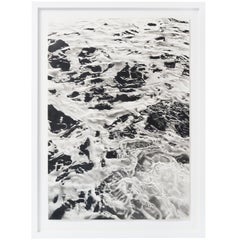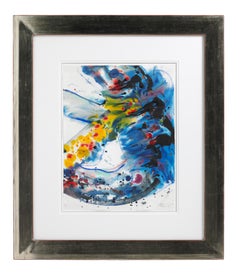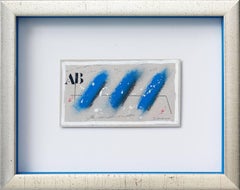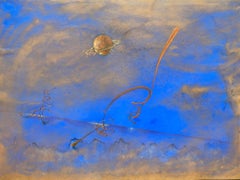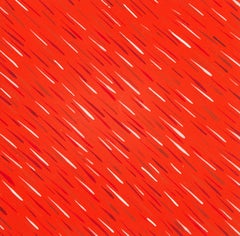Galleri GKM Siwert Bergstrom Abstract Drawings and Watercolors
to
7
3
4
3
1
3
3
Overall Height
to
Overall Width
to
4
2
1
4
3
1
3
3
2
1
1
4
3
2
2
2
Au bout, la lumière
By Philippe Huart
Located in Malmo, SE
Artwork size: 100x70 cm
Frame size 116x86 cm
Signed, titled and dated on the verso.
Acquired directly from the artist.
Free shipment worldwide.
Working on a variety of perceptual ...
Category
2010s Abstract Abstract Drawings and Watercolors
Materials
Paper, Pen, Graphite
Le jour se lève
By Philippe Huart
Located in Malmo, SE
Signed, titled and dated on the verso.
Acquired directly from the artist.
Free shipment worldwide.
Working on a variety of perceptual levels, Philippe Huart lets one visit his intim...
Category
2010s Abstract Abstract Drawings and Watercolors
Materials
Paper, Pen, Graphite
Foot Musik
By Roberto Matta
Located in Malmo, SE
Frame size 76x78 cm.
Free shipment worldwide.
Acquired directly from the artist.
Archive number (P90/41)
“The heart is an eye,” writes Nobel laureate Octavio Paz in an essay on Matta’s paintings. Matta creates a world coloured both by a sunny faith in the future and by visions of impending doom.
Roberto Sebastian Echaurren Antonio Matta, who died aged 91 on 23 November 2002, was born in Santiago, Chile, on 11 November 1911 into a family with Spanish, French and Basque roots, and raised in an atmosphere of religiosity. By the age of 21 he had graduated and begun work as an architect, but his leisure time he devoted to sketching and painting. In 1933 he travelled to Europe for the first time, visiting Greece, Yugoslavia, Italy and other countries, and subsequently taking the initiative to collaborate with the architect, Le Corbusier. As time passed, however, Matta’s enthusiasm for a career in architecture waned, and he began to devote himself full-time to art, making early acquaintances with surrealists such as Max Ernst, Salvador Dalí, André Breton and others.
Between 1939 and 1948 Matta, like many of his artistic contemporaries, lived in self-imposed exile in the USA, but, after almost 10 years’ absence from Europe, he returned to make first Rome and then, a few years later, Paris his home. Throughout most of the rest of his life Matta commuted between his studio in Paris and his creative refuge in the monastery outside Rome. And it is here, in Italy, that he produced his greatest paintings.
Matta’s first retrospective in Sweden was organised in 1956 when his works were exhibited in what was then Galerie Colibri – run by, among others, the artist C O Hultén...
Category
1990s Surrealist Drawings and Watercolor Paintings
Materials
Gouache, Mixed Media
SF 89-153.
By Sam Francis
Located in Malmo, SE
Artwork size: 67 x 51 cm.
Frame size: 112 x 97 cm.
Free shipment worldwide.
Archive number SF 89-153 in the Sam Francis Foundation.
Stamped with the Sam Francis Estate logo and stamped signature on verso.
Sam Francis’s paintings are a journey into a dream, a voyage into the landscapes of the soul where colours are lights on fire.
Alongside names such as Jackson Pollock, Willem de Kooning and Franz Kline, Sam Francis is an artist who has succeeded in demonstrating a total mastery of abstract expressionism’s impassioned and spontaneous genre.
The explosions of colour – red, blue, green and yellow – the streaks, strokes and bold lines of his pictures are the physical synthesis of the deepest crevices of the soul. His colours create rhythmical motifs that, characteristically enough, can be called the “musicality” of his paintings.
The work of Sam Francis provides a visible meeting place for the conscious and the unconscious. His pictures are the cross-fertilisation of what has already been experienced with what exists still only as desire, a struggle between melancholy and merrymaking.
Influenced by C.G. Jung, the father of psychoanalysis, Sam Francis spent a large portion of his life exploring the premise that dreams, instincts and intuition provide, the keys which unlock the mysteries and meaning of our inner lives. He was also fascinated by the four ancient elements – earth, water, air and fire – which developed into a leitmotif in his work.
Sam Francis was born in San Mateo in California, USA in 1923. After starting to paint at the age of around twenty, he soon found himself increasingly consumed by the power of art.
He spent much of the 1950s in Paris, from where he not only made frequent excursions to a number of European cities, but also embarked on many journeys to South America and Asia.
He continued to move from place to place, primarily in the USA and Japan, right up until his death in 1994.
Sam Francis’s first...
Category
1980s Contemporary Abstract Paintings
Materials
Paper, Acrylic
Foot Musik.
By Roberto Matta
Located in Malmo, SE
Pastel, gouache and coffee on paper.
Artwork size: 58 x 56 cm.
Frame size: 78 x 76 cm.
Free shipment worldwide.
Acquired directly from the artist.
Archive number (P90/37)
“The heart is an eye,” writes Nobel laureate Octavio Paz in an essay on Matta’s paintings. Matta creates a world coloured both by a sunny faith in the future and by visions of impending doom.
Roberto Sebastian Echaurren Antonio Matta, who died aged 91 on 23 November 2002, was born in Santiago, Chile, on 11 November 1911 into a family with Spanish, French and Basque roots, and raised in an atmosphere of religiosity. By the age of 21 he had graduated and begun work as an architect, but his leisure time he devoted to sketching and painting. In 1933 he travelled to Europe for the first time, visiting Greece, Yugoslavia, Italy and other countries, and subsequently taking the initiative to collaborate with the architect, Le Corbusier. As time passed, however, Matta’s enthusiasm for a career in architecture waned, and he began to devote himself full-time to art, making early acquaintances with surrealists such as Max Ernst, Salvador Dalí, André Breton and others.
Between 1939 and 1948 Matta, like many of his artistic contemporaries, lived in self-imposed exile in the USA, but, after almost 10 years’ absence from Europe, he returned to make first Rome and then, a few years later, Paris his home. Throughout most of the rest of his life Matta commuted between his studio in Paris and his creative refuge in the monastery outside Rome. And it is here, in Italy, that he produced his greatest paintings.
Matta’s first retrospective in Sweden was organised in 1956 when his works were exhibited in what was then Galerie Colibri – run by, among others, the artist C O Hultén at number 36 Södra Förstadsgatan in Malmö, Sweden. This was also the time when Matta began to collaborate with poets and other artists in Sweden. He produced the illustrations for Lasse Söderberg’s first anthology of poems, Akrobaterna (“The Acrobats”), published in 1955, and was also responsible for the cover of the Swedish art and literary magazine Salamander.
In 1959 the first museum exhibition of Matta’s work in Europe was arranged at the Museum of Modern Art (Moderna Museet) in Stockholm. Held under the aegis of Pontus Hultén, it was entitled “Fifteen Forms of Doubt” and included 15 or so gigantic paintings...
Category
1990s Abstract Mixed Media
Materials
Mixed Media
Trois bleus en diagonale.
By James Coignard
Located in Malmo, SE
Acquired directly from the artist.
Unique artwork.
Artwork size: 9,5 x 17 cm.
Frame size: 27 x 34 cm
Frame in silver.
Museum glass anti-reflective.
Free shipment worldwide.
“With ju...
Category
Early 2000s Abstract Mixed Media
Materials
Mixed Media
Foot Musik
By Roberto Matta
Located in Malmo, SE
Artwork size: 56 x 58 cm.
Frame size: 76 x 78 cm.
Free shipment worldwide.
Archive number (P90/36)
Acquired directly from the artist.
“The heart is an eye,” writes Nobel laureate Octavio Paz in an essay on Matta’s paintings. Matta creates a world coloured both by a sunny faith in the future and by visions of impending doom. Roberto Sebastian Echaurren Antonio Matta, who died aged 91 on 23 November 2002, was born in Santiago, Chile, on 11 November 1911 into a family with Spanish, French and Basque roots, and raised in an atmosphere of religiosity. By the age of 21 he had graduated and begun work as an architect, but his leisure time he devoted to sketching and painting. In 1933 he travelled to Europe for the first time, visiting Greece, Yugoslavia, Italy and other countries, and subsequently taking the initiative to collaborate with the architect, Le Corbusier. As time passed, however, Matta’s enthusiasm for a career in architecture waned, and he began to devote himself full-time to art, making early acquaintances with surrealists such as Max Ernst, Salvador Dalí, André Breton and others. Between 1939 and 1948 Matta, like many of his artistic contemporaries, lived in self-imposed exile in the USA, but, after almost 10 years’ absence from Europe, he returned to make first Rome and then, a few years later, Paris his home. Throughout most of the rest of his life Matta commuted between his studio in Paris and his creative refuge in the monastery outside Rome. And it is here, in Italy, that he produced his greatest paintings. Matta’s first retrospective in Sweden was organised in 1956 when his works were exhibited in what was then Galerie Colibri – run by, among others, the artist C O Hultén at number 36 Södra Förstadsgatan in Malmö, Sweden. This was also the time when Matta began to collaborate with poets and other artists in Sweden. He produced the illustrations for Lasse Söderberg’s first anthology of poems, Akrobaterna (“The Acrobats”), published in 1955, and was also responsible for the cover of the Swedish art and literary magazine Salamander. In 1959 the first museum exhibition of Matta’s work in Europe was arranged at the Museum of Modern Art (Moderna Museet) in Stockholm. Held under the aegis of Pontus Hultén, it was entitled “Fifteen Forms of Doubt” and included 15 or so gigantic paintings...
Category
1990s Surrealist Abstract Drawings and Watercolors
Materials
Mixed Media
Related Items
Paysage linéaire by José Gerson - Gouache on paper 69x50 cm
Located in Geneva, CH
Work on paper without frame
Category
1980s Surrealist Abstract Drawings and Watercolors
Materials
Pastel, Gouache, Carbon Pencil
H 27.17 in W 19.69 in D 0.4 in
"TORRENTS", Red and White Abstract Acrylic Painting
By Jim Houser
Located in Philadelphia, PA
This red and white abstract wall-hanging artwork titled "TORRENTS" is an original artwork by Jim Houser made of acrylic on panel. This piece mea...
Category
21st Century and Contemporary Contemporary Abstract Paintings
Materials
Paper, Acrylic, Panel
1957 Feminist Surrealist Israeli Colorful Watercolor Painting Myriam Bat Yosef
Located in Surfside, FL
Myriam Bat-Yosef
Surrealist abstract painting in colorful abstract shapes and shades in the style of Joan Miro
Hand signed and dated Tel Aviv, 1957.
frame measures 10 X 5.5 sheet measures 2.5 X 7 inches
The envelope of the Peter Buch poster is just for provenance and is not included in this sale.
Myriam Bat-Yosef, whose real name is Marion Hellerman, born on January 31 , 1931 in Berlin, Germany to a Jewish family from Lithuania, she is an Israeli-Icelandic artist who paints on papers, paintings, fabrics, objects and human beings for performances. Myriam Bat-Yosef currently lives and works in Paris. In 1933, her family fleeing the Nazi Holocaust, Myriam Bat-Yosef emigrates to Palestine and settles in Jaffa. In 1936, she suffers a family tragedy, her father, militant Zionist, is called to fight, still recovering from an operation of appendicitis. The incision will become infected, antibiotics did not exist yet, and her father will die in the hospital after 9 months of suffering.
Myriam and her mother leave Palestine to live in Paris for three years. French is Myriam's first school language. In 1939, still fleeing Nazism, she returned to Palestine, leaving France by the last boat from Marseille. She moved to Tel Aviv with her mother, aunt and maternal grandmother.
In 1940, she began attending the Academy of Fine Arts in Tel Aviv and took her name as an artist, Bat-Yosef, which means Joseph's daughter in Hebrew, as a tribute to her father. In 1946, Myriam graduated as a kindergarten teacher but wanted to be an artist. Her mother enrolled her in an evening school to prepare a diploma of art teacher. At 19, she performs two years of military service in Israel.
In 1952, with a pension of $50 a month that her mother allocated, she went to study at the Beaux-Arts in Paris. To survive, she has several activities while studying. In 1955, she had her first solo exhibition, at the Israeli Club on Wagram Avenue in Paris. Many artists, such as Yaacov Agam, Yehuda Neiman Avigdor Arikha, Raffi Kaiser, Dani Karavan and sculptors Achiam and Shlomo Selinger attended the opening .
In 1956, she enrolled at the School of Fine Arts in Florence. This is where she meets the painter Errô. They share an icy studio in winter. Myriam moves to Milan with friends. She organizes a joint exhibition with Erro, one room each, at the Montenapoleone gallery. Her works are admired by the sculptor Marino Marini and the painters Renato Birolli and Enrico Prampolini. Myriam and Erro exhibit in Rome, Milan, Florence and meet many personalities: Alain Jouffroy and his wife, the painter Manina, Roberto Matta and his wife Malitte, textile artist who was one of the founders of the Pompidou Center. Back in Paris, Myriam and Erro get married, which allows Myriam to avoid being called into the Israeli army during the Suez Canal War.
In 1957, Myriam and her husband went to Iceland. Myriam works in a chocolate factory. Having enough money, she starts producing art again. She exhibited in Reykjavik's first art gallery. She meets the artist Sigridur Bjornsdottir, married to the Swiss painter Dieter Roth .
In 1958, Myriam and her husband leave for Israel. They exhibit in Germany, then in Israel. Back in Paris, the couple became friends with artists of the surrealist movement, such as Victor Brauner, Hans Bellmer, the sculptor Philippe Hiquily, Liliane Lijn, future wife of Takis and photographer Nathalie Waag. Erro and Myriam have a daughter on March 15, 1960, named Tura, after the painter Cosmè Tura, but also close to the Icelandic Thora or the Hebrew Torah. Bat-Yosef’s complex trajectory throughout the 20th century is linked as much to the transnational history of what was for a time called the School of Paris as it is to a certain legacy of Surrealism. Her work features the same idea of resolving antinomies that also defined the spirit of surrealism, and is enhanced with her readings of the Kabbalah and her spiritual grounding in Taoism. However, while there are reasons for her approach to be associated with the process of the ready-made, it is important to consider the immediate intrication of these works with her practice of performance, during which the body itself is also painted – a feminist response to Yves Klein’s Anthropometries (1960) and an echo of the happenings which Jean-Jacques Lebel organised at the time in Paris.
In 1963, Erró told Myriam that if she wants to be a painter, she can not be his wife. Myriam chose to be a painter and the couple divorced in 1964. Since that time, Myriam Bat-Yosef has exhibited in many countries: Europe, United States, Japan, etc.
Although long in the shadows, the work of Myriam Bat-Yosef has been greeted by many artists and personalities: Anaïs Nin, Nancy Huston, André Pieyre of Mandiargues, José Pierre, René de Solier , Jacques Lacarrière, Alain Bosquet, Pierre Restany, Sarane Alexandrian and Surrealist André Breton who, after a visit to her studio, confided to having been intrigued by its phantasmagorical dimension. She was included in the book Pop Art and Beyond: Gender, Race, and Class in the Global Sixties by Mona Hadler and Kalliopi Minioudaki. Extract "World Citizen, Artist of the Pop Era Sarah Wilson; Why do we know so little of Myriam Bat-Yosef, the most important female Israeli artist of the Pop era? Issues of identity and sexuality feature constantly in her work. She exhibited internationally from Reykjavik to Tokyo; she had two shows at Arturo Schwarz’s famous Dada/surrealist gallery in Milan; she participated in feminist art events in Los Angeles. Above all, in 1971, she conceived Total Art, a Pop Gesamtkunstwerk inside and outside the Israel Museum, Jerusalem. Painter, performer, and installation artist, she was also a lover, wife, and mother. Of Lithuanian-Jewish descent, she was close to the family of philosopher Emmanuel Levinas. An émigré in Paris she would repudiate a national passport, participating in Garry Davis’s short-lived “World Citizens” movement. She continues the lineage of women surrealist artists: Valentine Hugo, Leonor Fini, Dorothea Tanning, Leonora Carrington, Unica Zürn, Jane Graverol, Toyen, Alice Rahon...
Category
1950s Surrealist Abstract Paintings
Materials
Watercolor
First Floor Biogram
By Kory Twaddle
Located in Kansas City, MO
Title : First Floor Biogram
Materials : Acrylic, gouache, oil pastel, marker, charcoal, graphite, and conté crayon on paper
Date : 2018
Dimensions : 24 x 18 x .1 in.
Description : ...
Category
2010s Abstract Expressionist Drawings and Watercolor Paintings
Materials
Paint, Conté, Paper, Oil Pastel, Acrylic, Permanent Marker, Tempera, Wat...
Collage Watercolor Painting David Gilhooly California Funk Surrealism MixedMedia
By David Gilhooly
Located in Surfside, FL
DAVID JAMES GILHOOLY (American, 1943-2013),
Mixed media collage
6 x 4 inches,
Hand signed and dated verso
Napoleon from the back, holding a heart.
cut and pasted cardstock assemblage, collaged art.
David Gilhooly RCA (1943 – 2013), was an American ceramicist, sculptor, painter, printmaker, and professor. He is best known for pioneering the Funk art movement. He made a series of ceramic frogs called FrogWorld, as well as ceramic food, planets, and other creatures.
David James Gilhooly III was born on April 15, 1943, in Auburn, California. He was raised in Los Altos, California; Saint Croix in the Virgin Islands; and Humacao, Puerto Rico.
He enrolled in University of California, Davis (UC Davis) initially studying biology, followed by anthropology, and ending with a focus on fine art. While attending UC Davis, Gilhooly served as artist Robert Arneson assistant starting in 1963. He graduated from UC Davis with a BA degree in 1965, and an MA degree in 1967.
Gilhooly, together with Robert Arneson, Peter Vandenberge, Chris Unterseher, and Margaret Dodd, working together in TB-9 (temporary building 9) were what was later to be called, The Funk Ceramic...
Category
2010s Surrealist Mixed Media
Materials
Paper, Ink, Watercolor
Etude 11 - abstract calligraphy ink drawing / painting on paper in black & white
By Nazanin Moghbeli
Located in Bryn Mawr, PA
Nazanin Moghbeli is an Iranian-American artist with training in Persian calligraphy, miniature painting, and music. She borrows techniques from Irania...
Category
2010s Abstract Abstract Drawings and Watercolors
Materials
Ink, Archival Paper, Graphite
Ode to Bob Lazar, 2020, gel pen, green, drawing, pink, ufo, science fiction, eye
By Macauley Norman
Located in Jersey City, NJ
Ode to Bob Lazar, 2020, gel pen ,ink and graphite on paper, green, abstract, drawing, pink, pattern, blue, yellow, black, ufo, science fiction, alien, yin ya...
Category
2010s Contemporary Abstract Drawings and Watercolors
Materials
Paper, Pen, Ink, Graphite
H 9 in W 11.75 in D 0.07 in
Untitled (Abstraction)
By Desmond McLean
Located in Chicago, IL
A black and white, Surrealist watercolor on paper by artist Desmond McLean in a cerused black frame.
McLean was born in Sligo, Ireland and raised in Brooklyn, NY. He was a professor...
Category
1950s Surrealist Abstract Drawings and Watercolors
Materials
Watercolor
Purple Orb 2 with Spinning, Flying Disks
By Nina Bovasso
Located in New York, NY
This is a unique work on paper made in 2018 measuring 20 x 25 inches from my ongoing "mound" series. This "Purple Orb" has a "companion" work ,made at the same time, the same size an...
Category
2010s Contemporary Abstract Drawings and Watercolors
Materials
Acrylic, Watercolor, Gouache, Archival Paper, Archival Ink
The sprinkling of defiled persons (drawing)
By Hunter Stabler
Located in Philadelphia, PA
This is an original drawing on paper by Hunter Stabler measuring 12”h x 12”w x 2.5”d framed. The piece is made from graphite, ink, transfer paper and Gelly Roll® pen on paper.
Hunter Stabler was born in Jefferson City, Missouri and was raised in upstate South Carolina. He received a BFA in painting from The Maryland Institute, College of Art and an MFA in painting from the University of Pennsylvania. He is currently pursuing an MFA in Digital Art at Louisiana State University. His work has been widely exhibited across the United States and internationally including exhibitions at the Morbid Anatomy Museum in Brooklyn, NY, The Shelburne Art Museum in Shelburne, VT, the Hunterdon Art Museum in Clinton, NJ, and the Islip Art Museum in East Islip, NY. His hand-cut paper artwork has been published in the books High Touch: Tactile Design and Visual Explorations, Push Paper, Strangers in the Nest (a book of Poems by Anselm Berrigan, Letterpress printed with images accompanying each poem), and published in Laminate Magazine, First Look Magazine, and American Craft Magazine. He was named “Philadelphia’s Next Hot...
Category
2010s Contemporary Figurative Drawings and Watercolors
Materials
Graphite, Paper, Ink, Ballpoint Pen
In Real Time, unique signed Abstract Expressionist painting compared to Matisse
By Steven Sorman
Located in New York, NY
Steven Sorman
In Real Time, 2003
Acrylic, gouache, gel medium, oil and beeswax collage painting on paper
48 × 34 inches
Signed and dated 2003; The frame also bears the original label...
Category
Early 2000s Abstract Expressionist Abstract Paintings
Materials
Mixed Media, Oil, Acrylic, Gouache, Gel Pen, Graphite
Cadaques No. 23, Surreal Nude Painting by Eduardo Arranz-Bravo
By Eduardo Arranz-Bravo
Located in Long Island City, NY
Artist: Eduardo Arranz-Bravo, Spanish (1941 - )
Title: Cadaques No.23
Year: 1994
Medium: Mixed Media (Watercolor and Color pencil) on paper, signed and dated
Size: 14 x 5 in. (35.56 ...
Category
1990s Surrealist Abstract Drawings and Watercolors
Materials
Watercolor, Color Pencil
